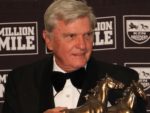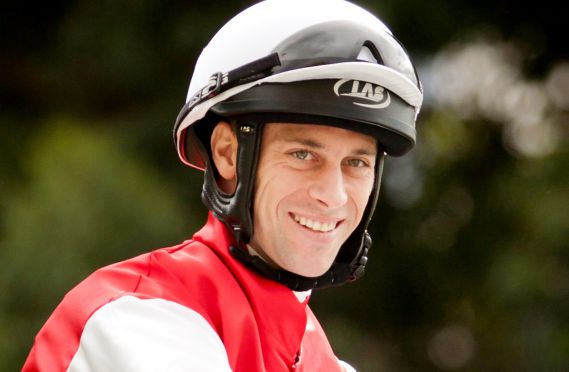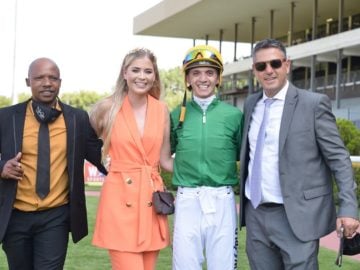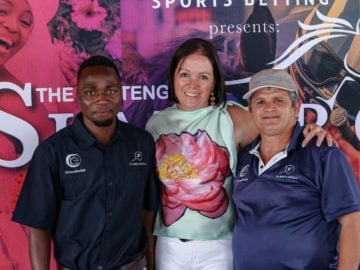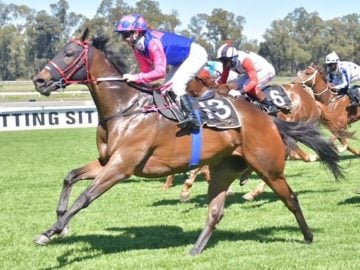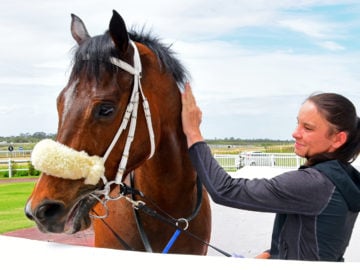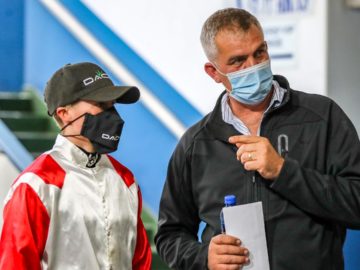With the racing industry becoming ever more competitive, it is interesting to see our locally produced riders spreading their wings to foreign racing jurisdictions, seeking international experience, earning foreign currency and getting to explore the world from the saddle.
Keanen Steyn is the polite, quietly spoken young rider, best remembered for piloting Mother Russia to her maiden victory. He has just returned home after a stint in India and tells us about his trip and plans for the future.
Getting started
Keanen grew up in Johannesburg and took a somewhat unconventional route to becoming a jockey. “None of my family are involved in racing. How it came about that I saw it on TV briefly one day when I was still very young. I approached my mom who said ‘No Keanen, it’s not for you, those guys are much smaller than you,’ but it intrigued me and lingered at the back of my mind.”
“Eventually you start asking yourself and your school starts asking what you want to do when you grow up and a couple of years later, I was in my first year of high school. I was quite outspoken – I went to the same school as my older sister, so everyone knew where I’d come from and that I was very sporty. Everyone knew me as a small guy and one day the deputy principle called me to office and handed me pamphlets to the Jockey Academy. At first I just glanced at it and said it’s not for me, but when I started reading the list of requirements, I realised I fit that and that and that and realise that perhaps it wasn’t out of my league. I got home and rang the number on the pamphlet and they set up an appointment at Turffontein a week or so later.”
“I joined the Academy in 2001, which was the same intake as Gavin Lerena, Raymond Danielson, Muzi Yeni and Richard Fourie – what a year!” he reflects.
Mother Russia
Partnering Mother Russia for her first two runs remains a career highlight. “She was definitely one of the special ones I’ve managed to ride. You would never have expected her to be what she was based on looks. She wasn’t ugly, but she felt like a completely different horse from the saddle than she looked from the ground. I remember riding her as a youngster a few times and we got on very well. She could be a little difficult to get out on to the track with other riders and in the end it was easier to put me back on. I made a point of sticking to her and trying to ride her every day. When I galloped her, I thought ‘there’s definitely something special here’. While Mr Ramsden was doing scratchings one day, I asked if I could rider her in her first start. He said ‘ja, ja, sure, we’ll see what’s in the race and let you know’. I was going to walk away, but then looked back and said ‘please can I ride her, I’ve been riding her every single day for the last few months and we’ve got a nice connection. I’d like to ride her first time.’ He glanced at me and said, ‘OK, ja sure.’ And he did. He held to his word and put me on and I won on her first time out at Kenilworth. Next time out she finished 4th in the Fillies Nursery and they realised she was something special,” he reminisces.
Getting in
India is not a country one immediately associates with horse racing, but Keanen is quick to say that they have a thriving racing industry. “Racing is huge there. Even on a normal racing day, the grandstand is packed. On big days they have to have security and actual guards just to keep public under control and everything in order. Racing is followed very widely.”
His first opportunity came by word of mouth. “I got an email from someone requesting a rider in India. I’d been referred by one of the local stud farms and I went over for the first time in 2011. I was there for four months before fracturing my foot. By the time my foot repaired, there would only have been a few weeks left of the season, so I was released from my contract early, but I did well and ran second on the log in one province.”
Rather than being contracted to a trainer, Keanen explains that it is easier to work for an owner. “You could go over for a trainer, but it’s very difficult and your opportunities are a lot less as you’re only allowed to ride for that trainer. However, if you’re contracted to an owner, you can ride any of the horses he has in training at any yard. It’s really strict – you’re only allowed to ride for your owner, even in the Graded races and outside jockeys are not allowed to ride syndicated horses, so generally it’s easier to go for an owner.”
“The second time I went was at the end of 2013 / beginning of 2014. I had an email from the Jockey Club saying that they had an owner requesting a rider. I’d ridden for him previously and was there for about 4 months when he got really ill. I was going to come back home, but just before I left I got offered a contract from another owner who has one of the top racing strings, so I came home briefly to renew my visa into their name and went over again last November.”
“The seasons work in 3 months at a time and I did 3 months at a couple of centres and 2 months in another. My last month was really quiet, so they said I could come back for a holiday. I really enjoyed my last stint – I was riding for a good owner with a lot of good horses in every centre and I did well.”
Racing in India
“The daily routine is fairly standard. You wake up at about 4:30 and get ready for track. Track opens at 5:30 and closes at 8:30 / 9am at the latest. Most trainers are done by 8:30 unless there’s gate practice. On those days there’s a siren at 8:55 and then the gates are brought onto the track. It’s very controlled and the tracks are very well run and managed.”
Remuneration
“You need to earn a minimum of $25k per annum, excluding stakes, but generally speaking, they pay you a lot more than that just for your services. They really do look after their jockeys and everything is taken care of. Wherever you go, you’re put up in flats or hotels and they provide transport. It’s all included in your contract and everything is very professionally done. There’s not even a question of having to ask for anything. It helps that they get a lot of international jockeys from England and Australia who ride there in the off season – over the years it’s been done that way and it’s just the norm for them now.”
“Stakes are mediocre compared to here and are maybe even a little less for your day to day racing. But when it comes to the higher level races, there’s a big jump and the stakes are really nice. If you compare the riding fee, then it works out at about R350, which is a lot less than here, but one doesn’t go for the riding fee, it’s mainly for your retainer and the opportunity to ride in their big races.”
“From a riding perspective, things are also run very differently there in terms of the way things are run and how you are treated. They ask your opinion and they trust you 100%. Obviously things go wrong from time to time, and when you come back you can see your owner or trainer is disappointed – and you’re disappointed, but what’s done is done. After races you go to dinner with the owner and trainer and discuss what happened and what you could maybe have done differently and then it’s over and done with and you move on.”
Culture shock
“I won’t lie, going alone isn’t easy. When I went in 2011, I had a girlfriend I’d been seeing for a while and that helped a lot, although it was still very daunting, but you’ve just got to put your head down and grind. Once I started meeting people, there were a good handful who were good to me, which really helped.”
“Living there is a big culture shock. The flats and hotels they put you in are completely different – it’s like walking into a 5 star hotel. My flat was fully equipped and furnished, clean and really beautiful. In saying that, if you stepped out of the flat and walked a couple of steps down the road, you were right in the middle of poverty. One hotel in Bombay was 7 star hotel and you could walk out straight onto the beach. But if you walked just a short distance down the road, you were back into poverty. It was there all the time, but it never really affected me as I was living in hotels and the minute I came out, there was a driver waiting for me.”
“The weather is another thing. I remember being in Bombay for a while – it was unbearably hot. The heat there is really hard – it’s like Durban, but the humidity is 5 – 10 times worse. Of all of it, that was the hardest to get used to. We don’t come from a cold climate, but when it gets hot there, you really feel it!”
What did you learn?
“It’s hard to explain, but I definitely brushed up on my racing. You have to learn to do things quicker. You have to be really, really quick. Racing is going so quick, you have to make a decision now and not wait and see where the horses are going. You have to commit or get left. You’re also only allowed to hit a horse 8 times, so you learn to save those hits. You save your horse for the last bit and only use the stick when necessary.”
“It taught me to be cleaner in my riding. They’re very strict and for any interference you get a suspension or a fine. Outside of racing I think it’s helped me be a bit more professional and learn to talk to people and owners and become more involved.”
Where to from here?
“I’m back in Cape Town now and I can ride at a bottom weight of 52kgs. I know it’s going to be difficult to get established again, so the main thing is to try and get my foot in the door. In Cape Town you can’t only ride for one yard, or you’ll end up with one or two rides at every meeting and ideally you need 4 – 6 rides, so you need support from a few stables. At the moment, my goal is just to get my foot in the door at a few yards, prove myself and move forward from there.”
“At the moment, I’m getting support from Mike Bass, Glen Kotzen is giving me quite a few rides, Joey Ramsden still helps me out whenever he can and then there’s the odd trainer here and there, like Mr Crawford in Phillippi. At this point, I’m going to try and focus on Cape Town. If I can start picking up rides in PE, I’ll start doing that again, but it’s a bit of a mission getting up and down with flights, etc.”
Despite the difficulties that racing faces and how competitive the industry is becoming, does he still think he made the right career choice? “I wouldn’t swap it for the world.”
‹ Previous
